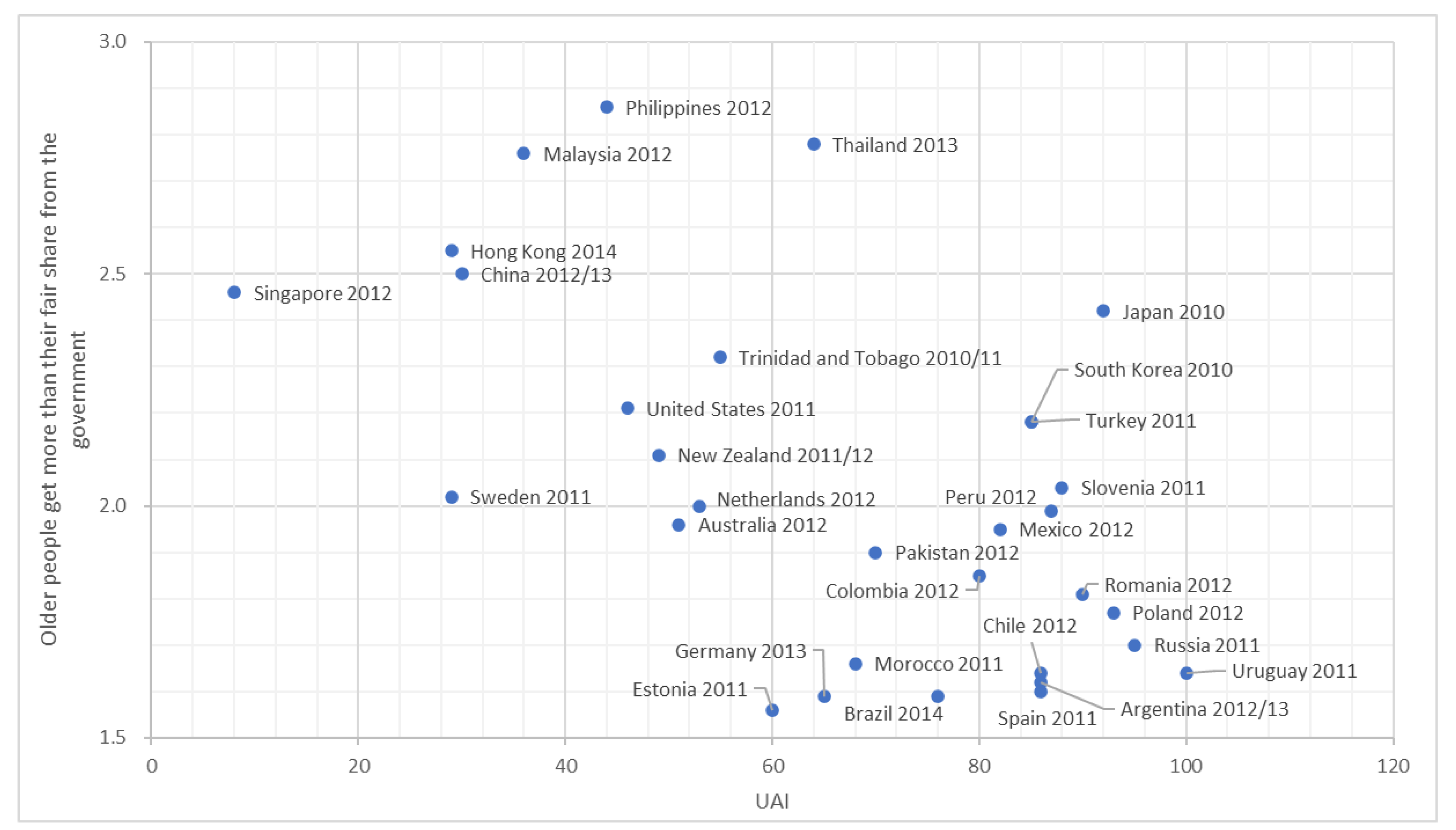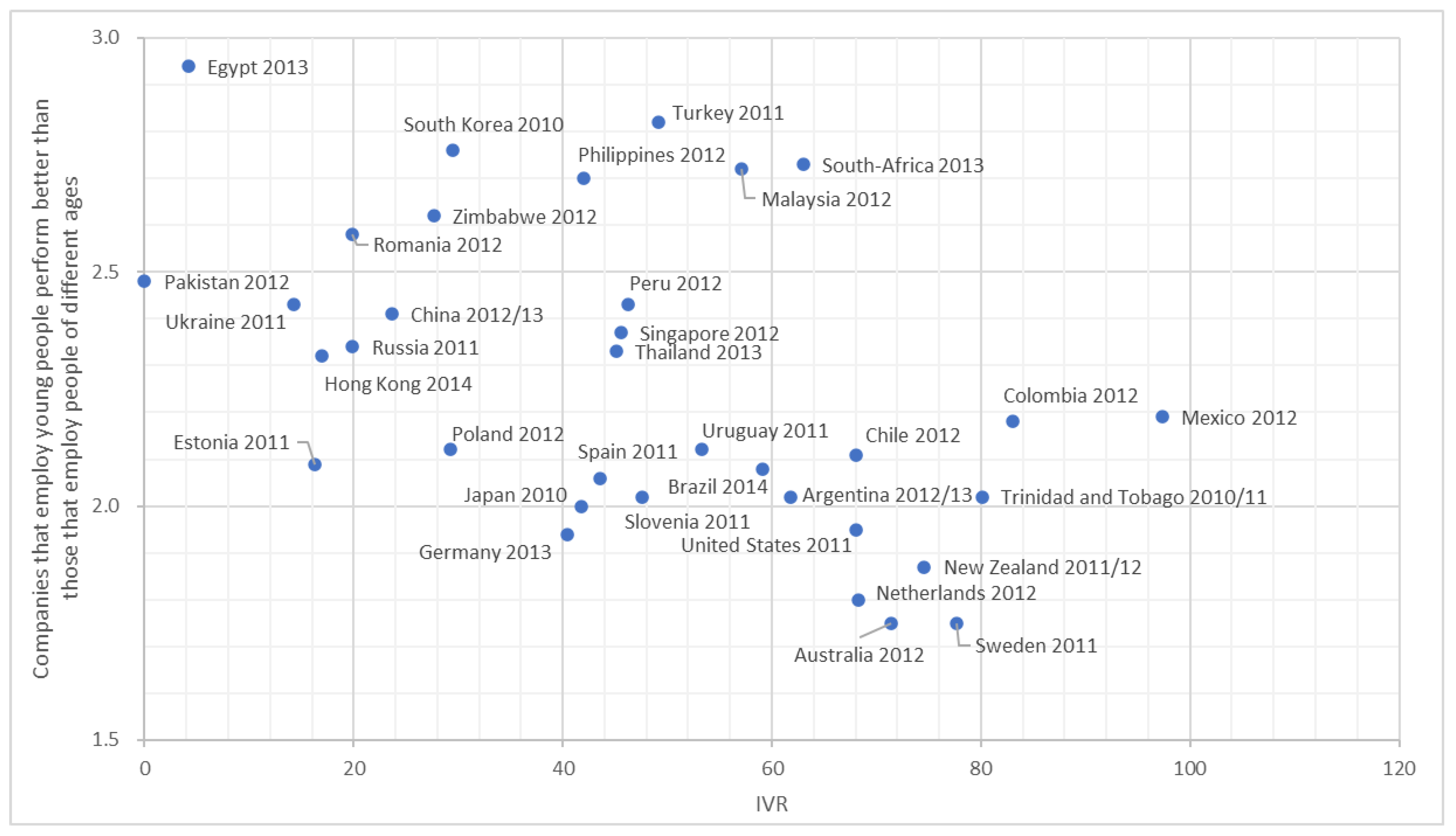Submitted:
09 August 2024
Posted:
12 August 2024
You are already at the latest version
Abstract
Keywords:
1. Introduction
2. Review of Previous Research and Presentation of Hypotheses
2.1. Hofstede’s Six Cultural Scales
2.2. Hypothesis Presentation Regarding the Relationship between Cultural Measures and Ageism
| Country and survey year | N |
| Argentina 2012/13 | 815 |
| Australia 2012 | 1,089 |
| Brazil 2014 | 1,214 |
| Chile 2012 | 801 |
| China 2012/13 | 1,945 |
| Colombia 2012 | 1,294 |
| Estonia 2011 | 1,108 |
| Germany 2013 | 1,406 |
| Hong Kong 2014 | 788 |
| Japan 2010 | 1,571 |
| South Korea 2010 | 977 |
| Malaysia 2012 | 1,177 |
| Mexico 2012 | 1,793 |
| Morocco 2011 | 1,076 |
| Netherlands 2012 | 1,119 |
| New Zealand 2011/12 | 547 |
| Pakistan 2012 | 1,148 |
| Peru 2012 | 1,031 |
| Philippines 2012 | 1,001 |
| Poland 2012 | 689 |
| Romania 2012 | 1,105 |
| Russia 2011 | 1,972 |
| Singapore 2012 | 1,484 |
| Slovenia 2011 | 758 |
| Spain 2011 | 854 |
| Sweden 2011 | 852 |
| Thailand 2013 | 1,050 |
| Trinidad and Tobago 2010/11 | 728 |
| Turkey 2011 | 1,406 |
| United States 2011 | 1,683 |
| Uruguay 2011 | 751 |
3.2. Measures
3.3. Control Variables
3.4. Analysis Method
4. Analysis and Findings
5. Discussion
6. Limitation
7. Conclusions
Funding
Institutional Review Board Statement
Informed Consent Statement
Data Availability Statement
Acknowledgments
Conflicts of Interest
References
- Hofstede, G.; Hofstede, G. J.; Minkov, M. Cultures and Organizations: Software of the Mind. Revised and expanded 3rd edition, New York: McGraw-Hill, 2010.
- Inglehart, R.; Haerpfer, C.; Moreno, A.; Welzel, C.; Kizilova, K.; Diez-Medrano, J.; Lagos, M.; Norris, P.; Ponarin, E.; Puranen, B. et al. (eds.). World Values Survey: Round Six - Country-Pooled Datafile Version, Madrid: JD Systems Institute, 2014. Retrieved from: https://www.worldvaluessurvey.org/WVSDocumentationWV6.jsp. (Accessed: 9 May 2024).
- Butler, R. N. Age-ism: Another form of bigotry. Gerontologist 1969, 9 Part 1, 243–246. [Google Scholar] [CrossRef]
- Löckenhoff, C. E.; De Fruyt, F.; Terracciano, A.; McCrae, R. R.; De Bolle, M.; Costa, P. T.; Aguilar-Vafaie, M. E.; Ahn, C.-k.; Ahn, H.-n.; Alcalay, L.; Allik, J.; Avdeyeva, T. V.; Barbaranelli, C.; Benet-Martínez, V.; Blatný, M.; Bratko, D.; Cain, T. R.; Crawford, J. T.; Lima, M. P.; Yik, M. Perceptions of aging across 26 cultures and their culture-level associates. Psychol. Aging 2009, 24, 941–954. [Google Scholar] [CrossRef] [PubMed]
- North, M. S.; Fiske, S. T. Modern attitudes toward older adults in the aging world: a cross-cultural meta-analysis. Psychol. Bull. 2015, 141, 993–1021, https://psycnet.apa.org/doi/10.1037/a0039469. [Google Scholar] [CrossRef] [PubMed]
- Marques, S.; Mariano, J.; Mendonça, J.; De Tavernier, W.; Hess, M.; Naegele, L.; Peixeiro, F.; Martins, D. Determinants of ageism against older adults: A systematic review. Int. J. Environ. Res. Public Health 2020, 17, 2560. [Google Scholar] [CrossRef] [PubMed]
- Vauclair, C. M.; Hanke, K.; Huang, L. L.; Abrams, D. Are Asian cultures really less ageist than Western ones? It depends on the questions asked. Int. J. Psychol. 2017, 52, 136–144. [Google Scholar] [CrossRef] [PubMed]
- Hofstede, G.; Bond, M. H. The Confucius connection: From cultural roots to economic growth. Organ. Dyn. 1988, 16, 5–21. [Google Scholar] [CrossRef]
- Inglehart, R.; Baker, W. E. Modernization, cultural change, and the persistence of traditional values. Am. Sociol. Rev. 2000, 65, 19–51. [Google Scholar] [CrossRef]
- LaFraniere, S. China might force visits to Mom and Dad. New York Times 2011, January 29. Retrieved from http://www.nytimes.com (Accessed: 9 May 2024).
- Ackerman, L. S.; Chopik, W. J. Cross-cultural comparisons in implicit and explicit age bias. Pers. Soc. Psychol. Bull. 2021, 47, 953–968. [Google Scholar] [CrossRef] [PubMed]
- Ramírez, L.; Palacios-Espinosa, X. Stereotypes about old age, social support, aging anxiety and evaluations of one's own health. J. Soc. Issues 2016, 72, 47–68. [Google Scholar] [CrossRef]
- Lawrie, S. I.; Eom, K.; Moza, D.; Gavreliuc, A.; Kim, H. S. Cultural variability in the association between age and well-being: The role of uncertainty avoidance. Psychol. Sci. 2020, 31, 51–64. [Google Scholar] [CrossRef] [PubMed]
- Ng, R.; Lim-Soh, J. W. Ageism linked to culture, not demographics: Evidence from an 8-billion-word corpus across 20 countries. J. Gerontol. B Psychol. Sci. Soc. Sci. 2021, 76, 1791–1798. [Google Scholar] [CrossRef] [PubMed]
- Pain, R.; Mowl, G.; Talbot, C. Difference and the negotiation of ‘old age’. Environ. Plan. D: Soc. Space 2000, 18, 377–393. [Google Scholar] [CrossRef]
- Hövermann, A.; Messner, S. F. Explaining when older persons are perceived as a burden: A cross-national analysis of ageism. Int. J. Comp. Sociol. 2023, 64, 3–21. [Google Scholar] [CrossRef]
- Gamlath, S. Human development and national culture: A multivariate exploration. Soc. Indic. Res. 2017, 133, 907–930. [Google Scholar] [CrossRef]
- Inglehart, R.; Welzel, C. Modernization, Cultural Change, and Democracy: The Human Development Sequence. New York: Cambridge University Press, 2005.
- Stevenson, B.; Wolfers, J. Economic growth and subjective well-being: Reassessing the Easterlin paradox (No. w14282). National Bureau of Economic Research, 2008.
- Chen, Z.; North, M. S.; Zhang, X. Pension Tension: Retirement Annuity Fosters Ageism Across Countries and Cultures. Innov. Aging 2023, 7, igad080. [Google Scholar] [CrossRef] [PubMed]
- World Bank. World Development Indicators, World Bank, 2024.
- United Nations. World Population Prospects 2022, United Nations, 2024.


| Item | Scoring method |
| “Social position: People in their 70s” (n = 33,402). | The analysis in this study used scores from 1 to 10 given for the 10-point Likert scale options ranging from "extremely low" to "extremely high." |
| “People over 70: are seen as friendly” (n = 33,619), “People over 70: are seen as competent” (n = 33,421), “People over 70: viewed with respect” (n = 33,831). | The six-point Likert scale options, ranging from "Not at all likely to be viewed that way" to "Very likely to be viewed that way," were scored from 0 to 5 and used for the analysis in this study. |
| “Is a 70-year old boss acceptable” (n = 33,878). | The analysis in this study used scores from 1 to 10 given for the 10-point Likert scale options ranging from "completely unacceptable" to "completely acceptable." |
| “Older people are not respected much these days” (n = 34,203), “Older people get more than their fair share from the government” (n = 33,159), “Older people are a burden on society” (n = 33,885), “Companies that employ young people perform better than those that employ people of different ages” (n = 32,456), “Old people have too much political influence” (n = 31,904). | A four-point Likert scale ranging from "Strongly agree" to "Strongly disagree" was used in the analysis of this study with the scores from 1 to 4 given for each option reversed. |
 |
Disclaimer/Publisher’s Note: The statements, opinions and data contained in all publications are solely those of the individual author(s) and contributor(s) and not of MDPI and/or the editor(s). MDPI and/or the editor(s) disclaim responsibility for any injury to people or property resulting from any ideas, methods, instructions or products referred to in the content. |
© 2024 by the authors. Licensee MDPI, Basel, Switzerland. This article is an open access article distributed under the terms and conditions of the Creative Commons Attribution (CC BY) license (http://creativecommons.org/licenses/by/4.0/).





